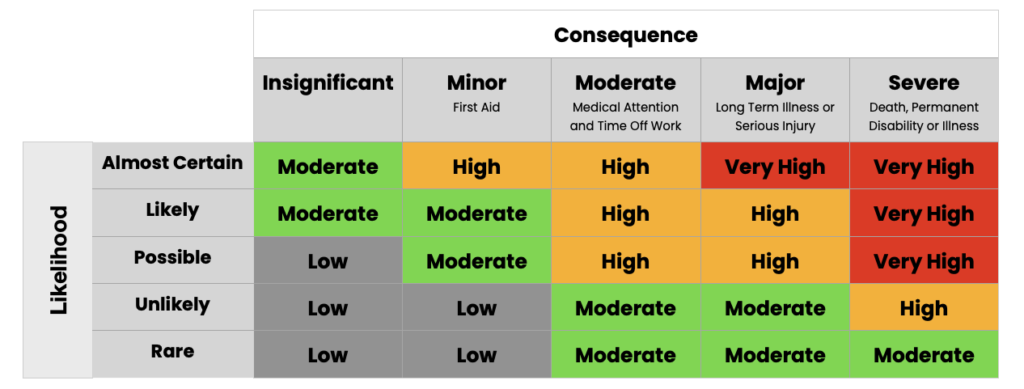Managing Risks associated with Confined Spaces
A risk assessment is mandatory for confined spaces under the WHS Regulations. As a person conducting a business or undertaking (PCBU), you must ensure that a risk assessment is conducted by a competent person and recorded in writing.
A risk assessment will determine the measures that should be implemented to control risks. It will help to:
identify which workers are at risk of exposure
determine what sources and processes are causing that risk
identify if and what kind of control measures should be implemented; and,
check the effectiveness of existing control measures.
Risk management is a systematic process to eliminate or minimise the potential for harm to people.
A hazard is something with the potential to cause harm.
A risk is the possibility that a hazard will cause harm.
For our purposes, harm includes:
Injury, illness or death of a person.
Damage to equipment or other property.
Therefore, Risk management is the process of eliminating hazards, or reducing risks. Elimination of hazards or reduction of risk is achieved through the application of controls.
Risk Assessment Process
Identifying Hazards
The first step in the risk management process is to identify all hazards associated with confined spaces. This involves finding things and situations which could potentially cause harm to people. Hazards generally arise from the following aspects of work and their interaction:
- physical work environment;
- equipment, materials and substances used;
- work tasks and how they are performed; and,
- work design and management.
Hazards may be identified by looking at the workplace and how work is carried out. It is also useful to talk to workers, manufacturers, suppliers and health and safety specialists and review relevant information, records and incident reports.
In managing the risks associated with a confined space the duty holder must identify reasonably foreseeable hazards that could give rise to health and safety risks.
The types of substances previously stored in a confined space (however briefly) will indicate the sorts of hazards that may be present. Substances stored in a confined space may result in a lack of oxygen, airborne contaminants or a flammable atmosphere within the confined space. Other hazards may arise from work activities, products or by-products in or around the confined space.
Many confined spaces’ hazards are invisible to the naked eye or not visible from outside the space, for example toxic gases, smaller spaces within a space and concealed electrical or mechanical parts.
Assessing the Risk
Once hazards and risks have been identified, the seriousness of the risk can be determined by considering the likelihood of it happening and the consequence if it did.
A table similar to the one below is often used in this process:

For example: A risk with a minor consequence which is unlikely to occur is going to be of less concern than a risk with a moderate consequence which is almost certain to occur.
Controlling the risks
Hierarchy of Control Measures
The WHS Regulations require duty holders to work through the hierarchy of control measures when managing certain risks; however, it can be applied to any risk. The hierarchy ranks control measures from the highest level of protection and reliability to the lowest. Further guidance on the risk management process and the hierarchy of control measures is in the Code of Practice: How to manage work health and safety risks.
As a person conducting a business or undertaking (PCBU), you should, as far as is reasonably practicable, ensure health and safety by taking into account and weighing up all relevant matters to control risk. For example putting in place control measures when confined space entry is a relatively infrequent activity for most workplaces.
Eliminating the Risk
You must always aim to eliminate the risk, for example by eliminating the need to enter a confined space. If eliminating the hazards and associated risks is not reasonably practicable, you must minimise the risk by one or more of the following:
Substitution — minimise the risk by substituting or replacing a hazard or hazardous work practice with something that gives rise to a lesser risk. For example, changing work methods to minimise time inside the confined space, therefore reducing likelihood of heat stress.
Isolation — minimise the risk by isolating or separating the hazard or hazardous work practice from any person exposed to it, for example by isolating moving or electric parts.
Engineering controls — engineering controls are physical control measures to minimise risk, for example forced extraction ventilation for large spaces, tanks, vessels.
If risk remains, it must be minimised by implementing administrative controls, so far as is reasonably practicable. For example, providing training relevant to working in confined spaces.
Any remaining risk must be minimised with suitable personal protective equipment (PPE). For example, respiratory protective equipment when oxygen levels are outside the safe range.
Administrative control measures and PPE do not control the hazard at the source. They rely on human behaviour and supervision and used on their own tend to be the least effective in minimising risks.
The WHS Regulations require a PCBU to consider certain relevant matters when managing risks, which will help to inform decisions about the most effective and appropriate risk control measures in the circumstances.
The WAHA would like to acknowledge the above information and guidance has been provided by the Safe Work Australia Model Code of Practice: Confined Spaces.
